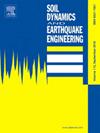Similarity design method for soil–structure–water models in centrifugal shaking table tests
IF 4.2
2区 工程技术
Q1 ENGINEERING, GEOLOGICAL
引用次数: 0
Abstract
In centrifugal shaking table tests, the reinforced concrete of the structural component of bridge pier prototypes is commonly replaced with aluminium alloy used in test models to replicate the elastic response of the structure. Moreover, the soil and water properties of the test model are typically consistent with those of the prototype. In the centrifugal dynamic model of a soil–structure–water system, establishing an appropriate similarity relationship is challenging because of the different materials used in the structural components of the test scale model and the prototype. To address this issue, an innovative similarity law is proposed for centrifugal shaking table tests to simulate the behaviour of soil–structure–water models. A numerical model of a deep-water bridge pier on a soft foundation was established and validated against centrifugal test results. Extensive numerical simulations were conducted to analyse the seismic responses of both the pier prototype and the scale model designed according to the proposed similarity law under the actions of the El Centro, Loma Prieta, and Kobe earthquakes. The results indicate that the maximum error in predicting the displacement and bending moment of the prototype using the scale model is 5.63 %, whereas the error for the hydrodynamic pressure and dynamic soil pressure is 14.98 %. Furthermore, when the proposed similarity law is applied to design a scale model for various water depths and seismic intensities during the El Centro earthquake, the maximum error in predicting the prototype displacements and bending moments is reduced to 5.34 %, with a maximum error of 14.79 % for hydrodynamic pressures and dynamic soil pressures. Therefore, the soil–structure–water model designed using the proposed similarity law can accurately predict the structural response in centrifugal shaking table tests.
求助全文
约1分钟内获得全文
求助全文
来源期刊

Soil Dynamics and Earthquake Engineering
工程技术-地球科学综合
CiteScore
7.50
自引率
15.00%
发文量
446
审稿时长
8 months
期刊介绍:
The journal aims to encourage and enhance the role of mechanics and other disciplines as they relate to earthquake engineering by providing opportunities for the publication of the work of applied mathematicians, engineers and other applied scientists involved in solving problems closely related to the field of earthquake engineering and geotechnical earthquake engineering.
Emphasis is placed on new concepts and techniques, but case histories will also be published if they enhance the presentation and understanding of new technical concepts.
 求助内容:
求助内容: 应助结果提醒方式:
应助结果提醒方式:


